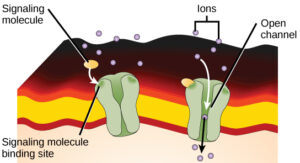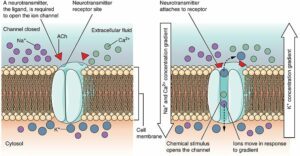Channel protein transport system is one of the most crucial transport systems among all pathways. Here we discuss all possible aspects regarding channel protein transport.
Channel proteins are special kind of integral membrane proteins which help some specific molecules (water and polar ions) to transport across the cell membrane and the system is known as channel protein transport system. In this pathway molecules are transported by the facilitated diffusion process only.
Are Channel Proteins Used To Transport?
Channel proteins are one of the most important proteins in the cellular membrane transport system.
Channel proteins are used to transport different small molecules (water, polar ions,etc.) across the plasma membrane. These proteins are highly specialized to open a pore or channel for some specific molecules as instructed. Through its hydrophilic channel it easily transports those specific molecules to their destination site.
The channel protein transport plays a very significant role in cellular activities. As most of the molecules that need to be transported are polar ions they face several difficulties to cross the membrane. The polar ions are repelled by the hydrophobic cell membrane and get many blockages in their pathway. The transportation rate is getting slow and that’s why it needs some medium to overcome this situation.
The channel proteins are the medium which covers the hydrophobic areas of the plasma membrane and exposes a hydrophilic passageway. The polar molecules easily cross the cell membrane through this passageway without interacting with the hydrophobic areas.
To know about Eukaryotic cells read our article on Eukaryotic Cells Examples: Detailed Insights
Can Channel Proteins Transport Molecules?
The main function of channel protein is to help in the transportation process across the cell membrane.
The channel proteins transport cellular molecules through its channel but the transportation process is highly specific for some determinate molecules. Some specific molecules which are exclusively transported by channel proteins are such as cellular water substance, polar ions like sodium ion (Na+), potassium ion (K+), calcium ion (Ca2+), and chloride ion(Cl−), proton molecules, etc.
Due to a highly specific transportation mechanism the channel proteins transport one specific or more similar molecule at a time. The channel protein transport poses a very high transportation rate like millions of ions per second.

Ion transport by channel proteins from Wikimedia commons
Channel Protein Transport Type
Facilated Diffusion process is the only type by which the channel protein transportation occurs.
Facilitated Diffusion
The channel proteins transport polar ions and water substances always via the facilitated diffusion process. This process does not require energy to proceed. The molecules flow from the higher concentration area to the lower concentration area of it, and tend to achieve the equal concentration.

Facilated Diffusion process from Wikimedia commons
Unlike the carrier proteins, the channel proteins only go for the facilitated diffusion process and not for the active transport mechanism because it only transports molecules down to their concentration gradient in the cell. The active transport mechanism is all about the transportation opposite from the diffusion process that means it allows molecules to move from their lower concentration area to higher concentration area.
How Do Channel Proteins Move?
Channel proteins act as a medium, providing a passageway for moving other cellular molecules.
Channel proteins help to move other molecules but do not move itself from its position. It neither binds with the molecules which are to be transported nor moves from its own position. After activation the channel proteins only open a pore or a hydrophilic channel through which molecules can be transported across the plasma membrane.
The specific molecules come towards the channel proteins and move across the plasma membrane by the facilitated diffusion process. Energy consumption is not required for these, molecules move freely from their higher concentration area to lower concentration area.
How Do Channel Proteins Function In A Plasma Membrane?
The channel proteins function in a plasma membrane by following some specific steps respectively.
- First, when some specific molecules like water substances or small polar ions of a cell need to be transported across the cell membrane, it needs the help of channel proteins.
- After this the channel protein nearby those molecules start functioning.
- In case of non gated channel proteins or leak channels, the protein complexe recognise the specific molecule and open a pore or channel for that particular molecule or similar molecules.
- In case of gated channel proteins, the protein complex needs some signal from the cell to open the channel.
- At this time some chemical signals (through some ions) or electrical signals ( through nerves, secretion of neurotransmitters) come to that channel proteins and trigger it for activation.
- After activation the channel protein opens a pore or channel for that particular molecule or similar molecules.
- After transportation when no other molecules are left to be transported, the coming cellular signal stops which marks the ending of transportation and the channel proteins close the passageway.

Ligand Gated channel proteins from Wikimedia commons
That is how the channel proteins function in the cell membrane. It transports specific molecules without requiring any energy, not going for binding or any configuration changes in its structure. Just activate, open a channel and after transportation close it.
How Will The Channel Protein Transport Substances?
The channel proteins transport substances (water and polar ions) by following up these specific steps mentioned below.
- When some cellular substance, mostly water and polar ions, try to cross the cell membrane to reach their destination site, they fail.
- The polar ions are repelled by the hydrophobic areas of the plasma membrane and also the transportation rate becomes so slow, they need channel proteins.
- The channel proteins after recognising that specific molecule open a channel.
- In case of gated channels some cellular signal (chemical or electrical signal) comes and triggers that protein.
- The protein then opens a pore or hydrophilic way for that molecule.
- The molecules diffuse through that channel down to their concentration gradient means they flow from higher concentration area to lower concentration.
- After completing the transportation process the signal stops and the channel proteins close the passageway.
This way the channel proteins transport water and polar ions through opening the channel for them.
How Protein Channel Facilitates Plant Transport Systems?
The channel proteins are situated in the cells of every living being including plant cells. They facilitate the water and ions transportation process within the plant cell.
In plant cells numbers of aquaporins and ion channels facilitate the water and ion transplantation. When the molecules need to be transported the channel proteins are getting activated by ligand binding, phosphorylation or chemical secretion process. They open a hydrophilic channel on the hydrophobic plasma membrane and the molecules flow down to their concentration gradient from those channels.
Plant cells have channel proteins all over their body cells including cells of root, leaf, branches, etc. In plant cells the water and ion transportation very important. The channel protein also facilitates transportation of small neutral solutes like urea, boric acid, silicic acid, etc.
To know more about plant cells read our article on Do humans have plant cells: Interesting Facts
As a whole we can say channel protein transport is very crucial to the membrane proteins transport system. We discuss the type of transportation process, and know how the channel proteins function within the cell membrane. Hope this article will be helpful to you.
Also Read:
- Lobster characteristics
- Cytoskeleton structure
- Are bacteria prokaryotes
- Multiple fruit example
- Chloroplasts in cytoplasm
- Is enzyme a catalyst
- Centipede examples
- Are cell wall an organelle
- Is nucleus a cell organelle
- Native species examples

Hello, I am Piyali Das, pursuing my Post Graduation in Zoology from Calcutta University. I am very passionate on Academic Article writing. My aim is to explain complex things in simple way through my writings for the readers.